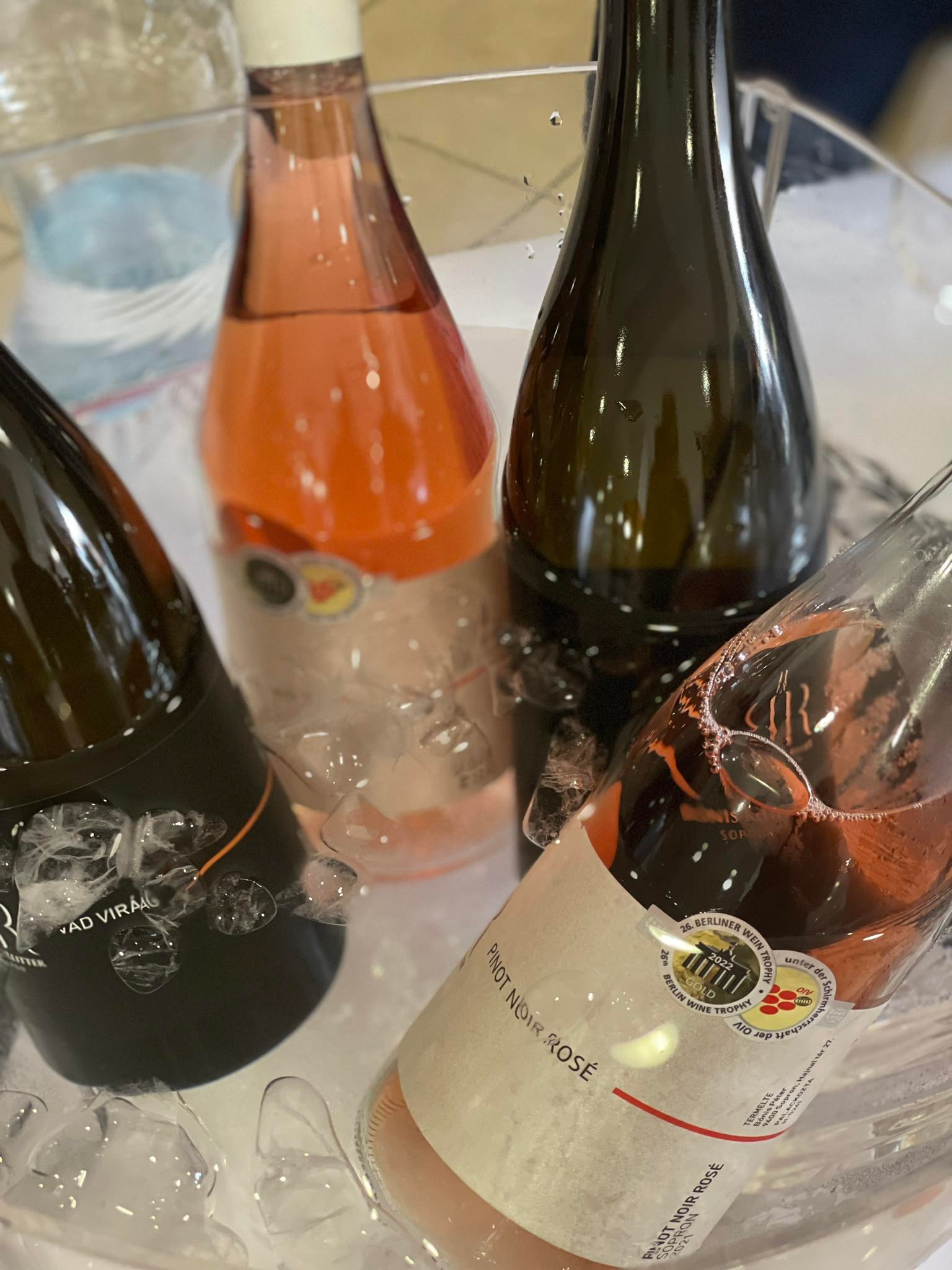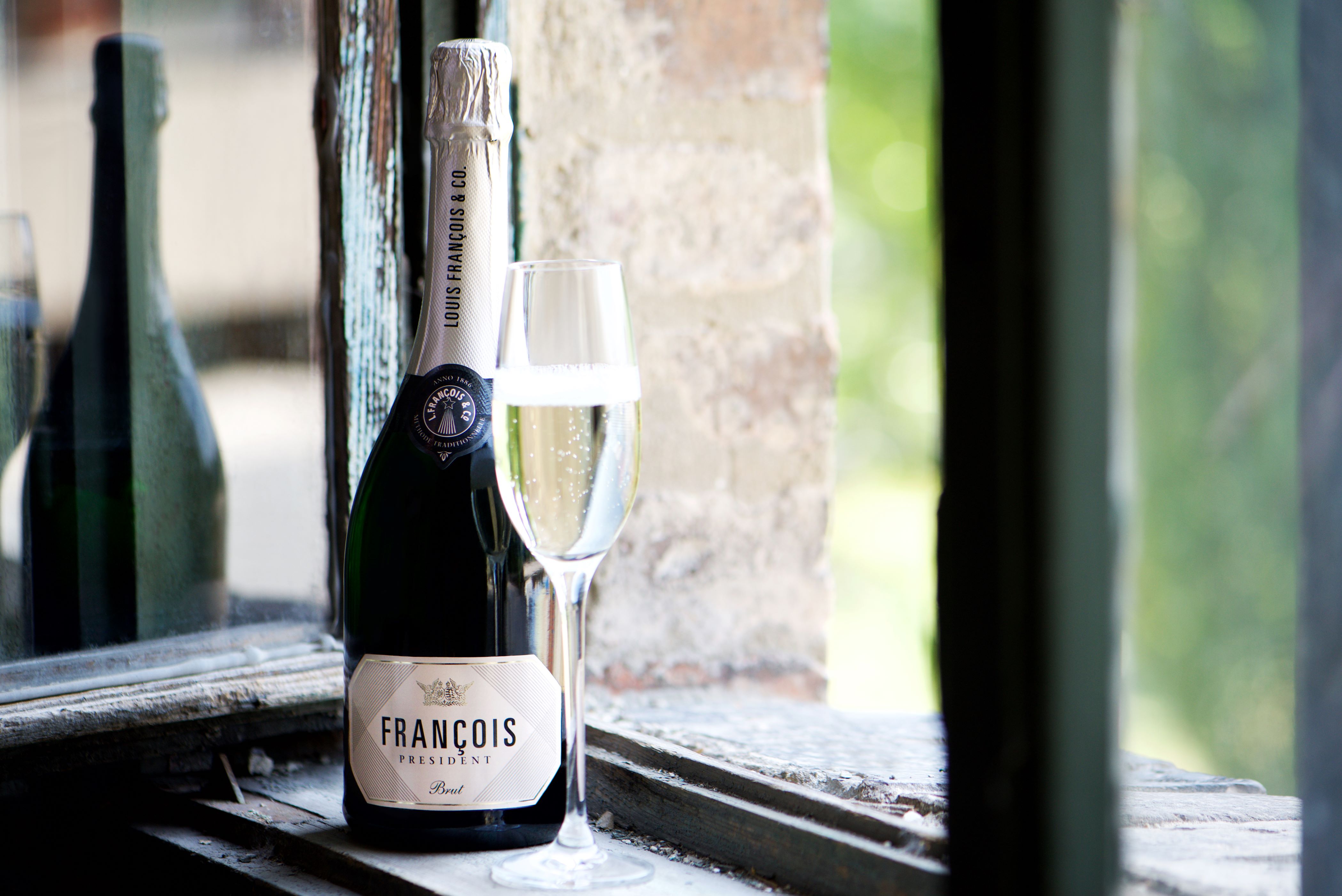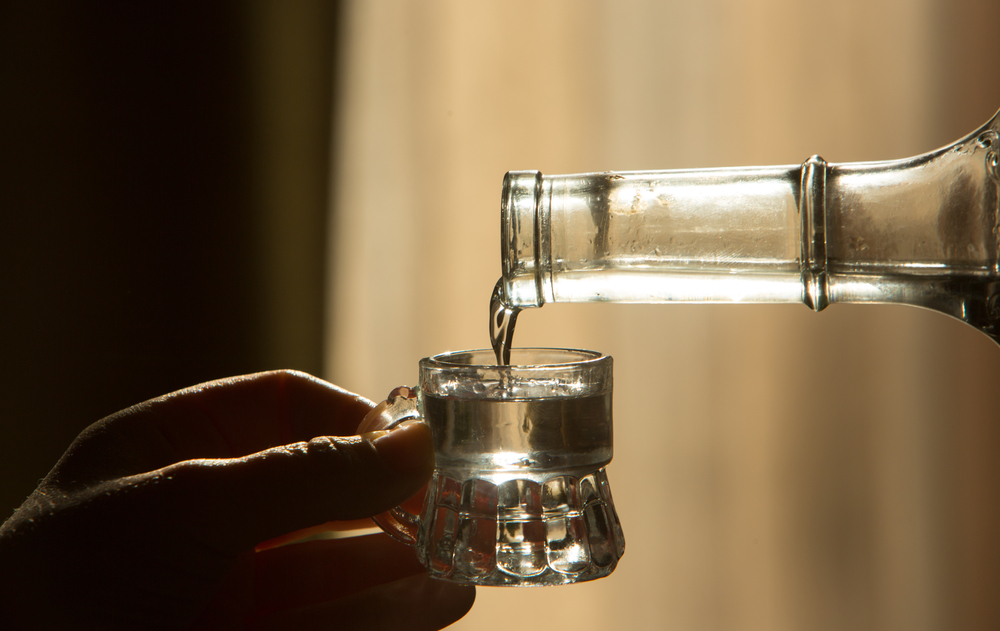Sopron Surprises as it Emerges From Burgenland’s Shadow

Bónis-Reitter’s rosé.
Photo by Or Szűcs.
As a wine region and a city, Sopron literally sticks out from the Hungarian pack. Hungary’s most loyal city (it voted in a referendum to remain part of the country in 1921) and its environs jut out into Austria’s Burgenland (itself once part of Hungary); the influence from the German-speaking world is pronounced.
Sopron has long been in the shadow of its Austrian neighbor, but finally, and I never thought I’d say it, some of the Kékfrankos (Blaufränkish) wines it is now making are of Burgenland-like quality.
At the Kékfrankoshangja event, held at the Ferenc Liszt Conference and Cultural Center in Sopron on October 4, it was striking how many new labels (several Hungarian with Germanic names) are coming through with wines made from Kékfrankos and other grape varieties.
The main white grape of the Sopron region is Zöldveltelini, the same grape as Grüner Veltliner in Austria, from where it originates. Wines made from this grape are often said to have aromas of white pepper, but so often, I find this isn’t the case.
However, this note is loud and clear in Stubenvoll Pince’s Zöldveltelini 2021. The cellar was founded as recently as 2020 and has 6.5 hectares of vines. It also produces Pét-Nat (from “pétillant naturel,” a French term that roughly translates to “naturally sparkling”), including a juicy rosé from Kékfrankos.
Another white grape that’s quite common in Sopron is Zenit (a crossing of Bouvier and Ezerjó created by Ferenc Király in 1951). Bónis-Reitter Borászat wowed with its Zenit offering, Vad Virág (Wildflower) 2019.
It was vinified in Austrian Stockinger barrels, is full-bodied, and very long. Although it has a hint of vanilla on the finish, the 15 months it spent in oak doesn’t override the other characteristics of the wine, with its abundant floral and tropical fruit notes. It costs HUF 3,200 from www.bonis-reitter.com.
The grapes for this wine came from the legendary Steiner vineyard, located next to Lake Neusiedl (Fertő). Another excellent wine from the Bónis-Reitter winery was its Pinot Noir rosé 2021, which spent eight hours on the skins before pressing and is really crispy, elegant and Provençal in style. It took home a gold medal from the Berliner Wine Trophy.
Spontaneous Ágnes
Zachar was another new name for me. It is a tiny winery and apartment operation where the wines are made by Ágnes Zachar, who has two hectares of Zöldveltelini, Chardonnay, and Kékfrankos vines on the banks of Lake Neusiedl. She goes for spontaneous fermentation in all her wines, which are concentrated and complex. They are available from borfalu.hu, which also has a store on Szondi utca in Budapest’s District VI.
The organic Horváth Borászat operation showed some really intense yet balanced reds from Kékfrankos, Cabernet Franc and Syrah varieties, which appear to be helped to ripen by warming temperatures though without the alcohol level shooting up.
At Steigler Pince, another organic winery, a meeting of minds between the owner and winemaker has reached an excellent standard in just three years. Tamás Varga worked as an assistant winemaker at the brilliant biodynamic Hans und Anita Nittnaus winery in Gols, Burgenland, when he met the like-minded Bálint Lőrincz at a wine club.
Heading down the steps into the winery’s several-hundred-year-old cellar on Balfi utca in Sopron’s old town to taste layered and textured wines from grapes such as Furmint, Zöldveltelini, Kékfrankos, Cabernet Franc, and Syrah is a great experience.
Steigler’s superbly spicy Syrah 2021 (HUF 5,900 from steigler.wineshop.hu) claimed 51st place in this year’s Winelovers 100 legjobb Magyar Bor (100 Best Hungarian Wines).
The quality from more established vintners was equally impressive. “Some people call me an industrial spy,” quipped Tibor Molnár, winemaker and owner at Vinceller, who brought back know-how from his time in Austria, where he worked with Fred Loimer in Kamptal and Anton Iby in Mittelburgenland.
He is a versatile winemaker, producing precise, pristine wines and exercising a flair for experimentation, such as Pét-Nat, Orange wine, and oak-aged rosé.
A 2014 Kékfrankos rosé he showed had been aged for two years in oak, but it was still really alive, without a hint of oxidation, with zesty freshness to complement the tobacco and waxy notes from the oak and the long bottle aging. He also makes a nice dry Zenit, as well as a botrytized sweet version. Molnár also serves as president of the Sopron wine route.
Sister Act
The Austrian-born Pfneiszl sisters, Birgit and Katrin (who attended school in Hungary), presented a fine pair of Kékfrankos wines that cleverly captured the versatility of the grape variety. The first, Kékfrankos ‘Together Again’ 2021, was briefly aged, mainly in the tanks, and was bottled early, before last Christmas.
It is light-bodied, fresh, floral and fruity, oozing the grape variety’s trademark sour cherry notes, with light tannins and soft acidity, and costs HUF 3,000 from pfneiszl.hu.
The second, Kékfrankos ‘Black Pearl’ 2019, was fuller-bodied, aged for 22 months in mainly used Hungarian oak barrels, with hints of dark chocolate nicely complementing the soft, juicy sour cherry and other red fruit. This version costs HUF 4,800. Both wines slipped down a treat.
Luka Pincészet’s Kékfrankos was also classy, although a visit to the bijou winery in Fertőrákos the next day revealed Enikő Luka’s love of another grape variety that Blaufränkish parented, together with St. Laurent: Zweigelt. It was crossed by Dr. Fritz Zweigelt in 1922 at the Teaching and Research Center for Viticulture and Horticulture in Klosterneuburg, close to Vienna. It is now Austria’s most planted black grape, and Luka has long led the way with the variety in Hungary.
Enikő Luka’s father, József, believed greatly in the potential of Zweigelt to produce fine wines in the mica-schist and limestone terroir of the Sopron wine region. As a child, she fell in love with the vibrant purple color of the fermenting must of the Zweigelt. Today, purple leads the color scheme of the tasting room.
Rebeka Takács joined as the winemaker in 2020 and attends the 3.5 hectares of vines, replacing Gergely Magas, with whom Luka worked for years. Luka now emphasizes the female touch on both the physical and sensory sides.
“The barrels have to be small enough so that we women can carry them. My husband drives the tractor,” says Luka. Austrian Rudi Krizan, the one-time winemaker of Etyeki Kúria, also helps as a consultant. Incidentally, Etyeki Kúria, based in the Etyek region just 28 km west of Budapest, has been stepping up its presence in Sopron and is expected to open a winery in the area soon.
This article was first published in the Budapest Business Journal print issue of October 21, 2022.
SUPPORT THE BUDAPEST BUSINESS JOURNAL
Producing journalism that is worthy of the name is a costly business. For 27 years, the publishers, editors and reporters of the Budapest Business Journal have striven to bring you business news that works, information that you can trust, that is factual, accurate and presented without fear or favor.
Newspaper organizations across the globe have struggled to find a business model that allows them to continue to excel, without compromising their ability to perform. Most recently, some have experimented with the idea of involving their most important stakeholders, their readers.
We would like to offer that same opportunity to our readers. We would like to invite you to help us deliver the quality business journalism you require. Hit our Support the BBJ button and you can choose the how much and how often you send us your contributions.








